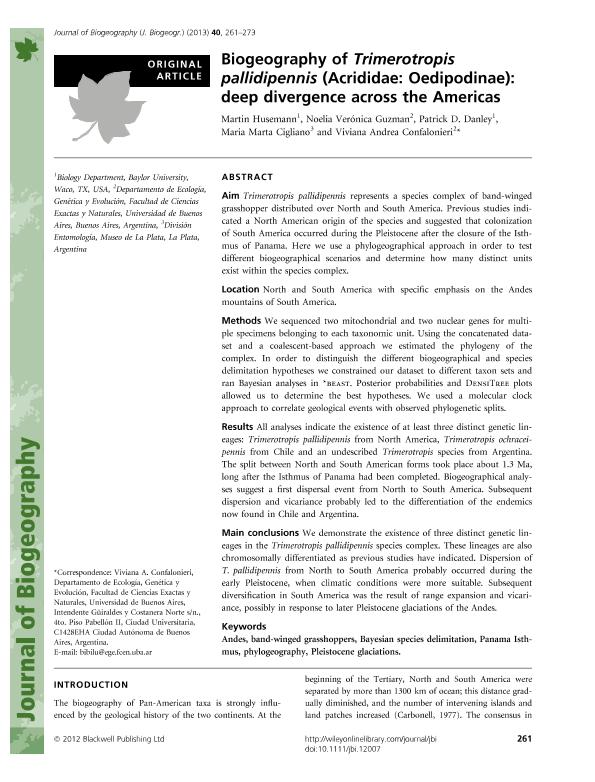Mostrar el registro sencillo del ítem
dc.contributor.author
Husemann, Martín
dc.contributor.author
Guzman, Noelia Veronica

dc.contributor.author
Danley, Patrick D.
dc.contributor.author
Cigliano, Maria Marta

dc.contributor.author
Confalonieri, Viviana Andrea

dc.date.available
2017-01-18T18:06:21Z
dc.date.issued
2013-04
dc.identifier.citation
Husemann, Martín; Guzman, Noelia Veronica; Danley, Patrick D.; Cigliano, Maria Marta; Confalonieri, Viviana Andrea; Biogeography of Trimerotropis pallidipennis (Acrididae: Oedipodinae): deep divergence across the Americas; Wiley; Journal Of Biogeography; 40; 2; 4-2013; 261-273
dc.identifier.issn
0305-0270
dc.identifier.uri
http://hdl.handle.net/11336/11560
dc.description.abstract
Aim Trimerotropis pallidipennis is a species complex of band-winged grasshopper distributed over North and South America. Previous studies indicated a North American origin of the species and suggested that colonization of South America occurred during the Pleistocene after the closure of the Isthmus of Panama. Here we use a phylogeographical approach in order to test different biogeographical scenarios and determine how many distinct units exist within the species complex. Location North and South America with specific emphasis on the Andes mountains of South America. Methods We sequenced two mitochondrial and two nuclear genes for multiple specimens belonging to each taxonomical unit. Using the concatenated dataset and a coalescent-based approach we estimated the phylogeny of the complex. In order to distinguish the different biogeographical and species delimitation hypotheses we constrained our dataset to different taxon sets and ran Bayesian analyses in *beast. Posterior probabilities and DensiTree plots allowed us to determine the best hypotheses. We used a molecular clock approach to correlate geological events with observed phylogenetic splits. Results All analyses indicate the existence of at least three distinct genetic lineages: Trimerotropis pallidipennis from North America, Trimerotropis ochracei- pennis from Chile and an undescribed Trimerotropis species from Argentina. The split between North and South American forms took place about 1.3 Ma, long after the Isthmus of Panama had been completed. Biogeographical analyses suggest a first dispersal event from North to South America. Subsequent dispersion and vicariance probably led to the differentiation of the endemics now found in Chile and Argentina. Main conclusions We demonstrate the existence of three distinct genetic lineages in the Trimerotropis pallidipennis species complex. These lineages are also chromosomally differentiated as previous studies have indicated. Dispersion of T. pallidipennis from North to South America probably occurred during the early Pleistocene, when climatic conditions were more suitable. Subsequent diversification in South America was the result of range expansion and vicariance, possibly in response to later Pleistocene glaciations of the Andes.
dc.format
application/pdf
dc.language.iso
eng
dc.publisher
Wiley

dc.rights
info:eu-repo/semantics/openAccess
dc.rights.uri
https://creativecommons.org/licenses/by-nc-sa/2.5/ar/
dc.subject
Andes
dc.subject
Grasshopper
dc.subject
Bayesian Species Delimitation
dc.subject
Panama Iisthmus
dc.subject.classification
Biología

dc.subject.classification
Ciencias Biológicas

dc.subject.classification
CIENCIAS NATURALES Y EXACTAS

dc.title
Biogeography of Trimerotropis pallidipennis (Acrididae: Oedipodinae): deep divergence across the Americas
dc.type
info:eu-repo/semantics/article
dc.type
info:ar-repo/semantics/artículo
dc.type
info:eu-repo/semantics/publishedVersion
dc.date.updated
2016-12-12T14:09:15Z
dc.journal.volume
40
dc.journal.number
2
dc.journal.pagination
261-273
dc.journal.pais
Reino Unido

dc.journal.ciudad
Londres
dc.description.fil
Fil: Husemann, Martín. Baylor University; Estados Unidos
dc.description.fil
Fil: Guzman, Noelia Veronica. Universidad de Buenos Aires. Facultad de Ciencias Exactas y Naturales. Departamento de Ecología, Genética y Evolución; Argentina. Consejo Nacional de Investigaciones Científicas y Técnicas. Oficina de Coordinación Administrativa Ciudad Universitaria. Instituto de Ecología, Genética y Evolución de Buenos Aires; Argentina
dc.description.fil
Fil: Danley, Patrick D.. Baylor University; Estados Unidos
dc.description.fil
Fil: Cigliano, Maria Marta. Universidad Nacional de La Plata. Facultad de Ciencias Naturales y Museo. División Entomología; Argentina. Consejo Nacional de Investigaciones Científicas y Técnicas; Argentina
dc.description.fil
Fil: Confalonieri, Viviana Andrea. Universidad de Buenos Aires. Facultad de Ciencias Exactas y Naturales. Departamento de Ecología, Genética y Evolución; Argentina. Consejo Nacional de Investigaciones Científicas y Técnicas. Oficina de Coordinación Administrativa Ciudad Universitaria. Instituto de Ecología, Genética y Evolución de Buenos Aires; Argentina
dc.journal.title
Journal Of Biogeography

dc.relation.alternativeid
info:eu-repo/semantics/altIdentifier/url/http://onlinelibrary.wiley.com/doi/10.1111/jbi.12007/abstract
dc.relation.alternativeid
info:eu-repo/semantics/altIdentifier/url/http://dx.doi.org/10.1111/jbi.12007
Archivos asociados
